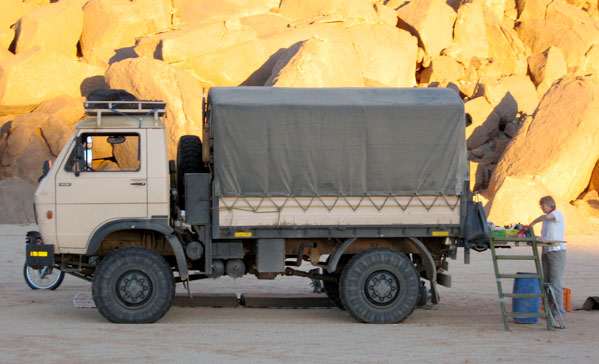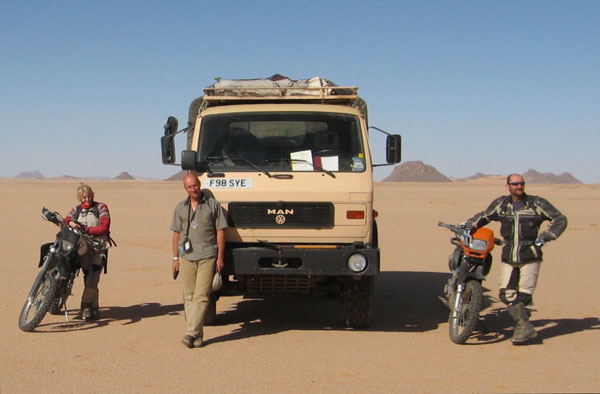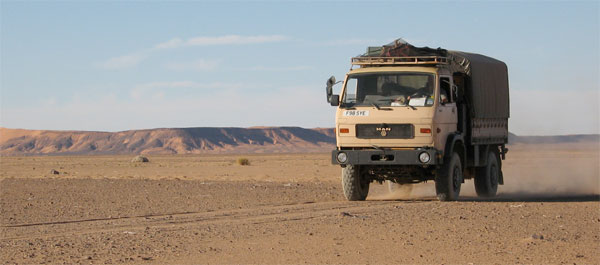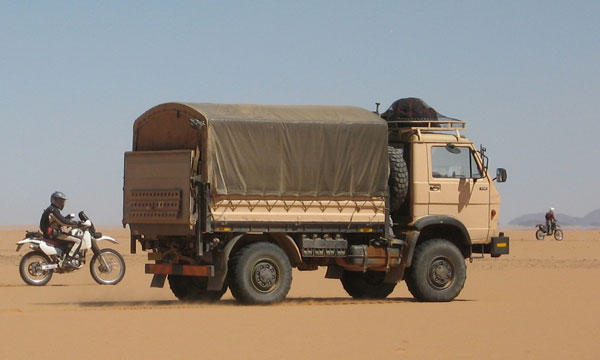VW MAN 8.136 ~ A small truck for the Sahara
Previous ......................... . Last
Heading off to Algeria having only driven the unproven MAN down from Matlock, cramming it full of bikes and gear and heading for Portsmouth was of course not ideal. But, as much as any old banger I’ve bought, I had confidence in this one. The motor and trans had less miles than my girlfriend’s 05 Micra, only the rubber components – not least the tyres – were a worry, along with all the usual anxieties.
Matt came with me to Marseille do the lion’s share of the driving and we got from Le Havre to near Montpellier in a day. Not bad at 80 clicks but it did involve on-the move driver swaps and only a 20-min break in 14 hours.
The load of only around 1.5 tons did not make much of an impression on performance and on the hilly-but-free A7 autoroute over the Massif it was no slower uphill than my late Hilux.
Fuel consumption
MPG was the big unknown but turned out much better than the 10mpg expected: sitting on 80kph we eked out an all-time-best of 5.6kpl or nearly 17 mpg. More normal road figures were in the 14mpg range. Off road figures in the desert, including some tricky cross-country driving, sand sheet, rock fields, reg and all the rest came in at around 3.5kpl or just under 10mpg. This was with a modest fuel and water load of up to 800kg at the start of each of the three 800km stages.
On the road
As mentioned earlier, driving the 8.136 is much easier than expected; you get great visibility, good turning circle and are never going fast enough to get into trouble. Just as well as the mass and short wheelbase of the machine felt quite intimidating when hitting an experimental 125kph in neutral down a long A7 hill on the way back. Handy to know but I won’t be trying that again. Road and engine noise are very good with the windows closed, but once open, the norm in the desert, it comes at you from all sides. Grinding through the sands it was too noisy and attention demanding to hear a sat phone ringing.
On the dirt
Off road took some getting used to. Perhaps the biggest drawback of trucks like these is that you’re sitting just ahead of the front axle. Whereas in a 4x4 station wagon you’re sat at the neutral pivot point of the seesaw (the seat at each end representing an axle), in an FC lorry you’re even beyond the ‘seat’ and so suspension travel becomes body travel too and is much the limiting factor in off road speed. The sprung driver’s seat helped greatly but wearing a seatbelt off road (desirable in a tank like this) was not possible as it was attached to the cab floor and so locked up hard on every jerk. Interestingly one of the riders observed that the high walled tyres accounted for much of the suspension (I ran them at a ‘high-as-possible, low-as-necessary’ 35-40 psi on the sands and 50 fully loaded on the highway).
Driving across run-off channels too close to mountains and hills was the worst as it forever broke any rhythm and dropped speeds dramatically and frustratingly until I adopted a more Buddhistic approach to progress.
It’s common to claim that one’s chosen vehicle is the best there is but elsewhere off road the agility of the 8136 was quite an eye opener. My conclusion was that gearing had a lot to do with it (even off road you run only 2nd to 5th), aided by the foot of ground clearance and pretty good tyres. At the low 20s they got the lorry back over the Erg Admer crossing in one go (on the way out it
was more of a messy learning curve reminiscent of my 101 crossing in ’88 as described is Desert Travels. That time I had to learn the value of low tyre pressures; this time it was remembering that this thing had a central diff lock. After that I learned to turn on the air-controlled switch when anything tricky lay ahead.)
I wished I could have got some pictures of the crossed-up MAN at full chassis twist squeezing through some narrow off-piste pass or working its way through a dune-filled oued. You just have to take it from me the big tyres and clearance, gearing which makes the most of the 136hp, more diff locks than door locks, short wheelbase and great visibility gave the little MAN mobility that was never worse than the accompanying guide’ 80. But you can’t get 8 bikes and the provisions for 3 weeks in the back of a TLC.
Another thing that became apparent, although was not altogether surprising, was the vehicle’s toughness in taking its off road beating. As mentioned, the tyre suspension had much to do with it, but the OE shocks seem to have survived without puking up their innards and the springs beat off endless misjudged hits. Nothing broke, leaked or came loose.
Vehicle adaptations
All of Matt’s work performed faultlessly. I was worried the tail lift would break off or burn up but, although the running chains got gritty with sand, it never missed a beat and was probably the best thing we could have done to the lorry.
I barely used the rear spotlight as it was wired up to the main bats and I didn’t get around to wiring it to the aux ones. Anyway, the much less powerful inside fluo lights were fine for cooking on the tail lift.
The inverter in the cab survived although the 4-way cig socket wiring got chaffed in half by the bouncing cab body and was easily fixed by a re-routing. Sand plates on the back of the raised tail lift were very handy for the 4 or 5 times I got bogged and the air line extensions on each side of the body were very handy, although one old bit of airline section developed a leak.
Vehicle problems
The worst thing that happened was the clutch slave cylinder went. It took a couple of weeks from when I first noticed (and discovered where and what a slave cylinder looked like). One of the riders who had years of Landrovering behind him assured me they can take months to go as long as you keep topping up. But leaking LR slave cylinders are a common problem because they are probably badly made from the start. When it finally went we were in a crumby auberge in Hassi Messaoud – a rough oil town full of heavy machinery. As luck would have it not two minutes walk away was a lorry parts place which dug out a slave cylinder seal matching mine, and between that place and the auberge was a resto for some nosebag, a natty clothes shop for an urgently needed new pair of trousers, a place that sold clutch fluid and another place that cleaned out the rust that had formed over the years inside the cylinder in front of the piston and which obviously knackered the seal. With a 1000kms and a ferry to catch in less than 48 hours, the whole delay cost us just £3 and 3 hours.
The tyres, which worryingly had “Made in West Germany’ stamped on the sides, held up OK as I made sure to keep them on the firm side, but by the end they were full of cracks and are not up to another desert trip.
A steering wobble developed on turns which occasionally got very bad once back in France. For a depressing moment in Millau I thought I might have bent an axle or something after one day in the desert when the whole rig jumped 2 metres off some sand ridges made invisible by late afternoon backlight (one rider hit one of these hard and mashed himself up pretty badly – like ‘hitting a landmine’ was how he described it). But I needn’t have worried, an out of hours call to Matt the Lorry Doctor came up with some possible causes: shagged steering damper? could not find one; worn track rod ends? as solid as a cricket ball; a badly worn tyre? Sounded plausible and sure enough on fitting the spare the MAN rolled smoothly up to Le Havre and home. Thank you lorry doctor.
It’s possible there is a leak in the air system – to be expected after the bashing, but it seems irregular. I still haven't got to the bottom of air brakes and whether overnight cooling in the tanks reduces the pressure significantly. Anyway, on some morning sit only takes only a minute or two on tick over to release the brakes and charge the tanks back up to 8 bar.
And that’s it. The thing never got hot (85°C was max – 90 being the red zone) although I did whack on the heater and fan for the slow dune ascents. No punctures. Not a single thing broke off or came loose or leaked (apart from the air?) nor even a glass jar got smashed in the back.
Future adaptations
I may well do another bike tour to get the lorry to pay for itself but will need to make some improvements to:• Petrol, diesel and water storage (this time I used a local oil drum for petrol and water bags and drums for water).
• Spotlights on the roof rack would greatly improve night time visibility (see movie).
• Space could be made by removing the whole rear heater system and using it for a tank
• Mich XZL tyres – maybe on tubeless rims
• Better storage and general utility in the cab
• A tank underneath the rear chassis somewhere
• Replace OE tank and 4 jerries with a single 200-250L lorry tank
• A radio would be nice
MAN good
More economical than expected
Easy and even fun to drive for an ex-army lorry
Tough and reliable
Feels like it could crawl anywhere if it had to
Short, so not a handful in town
Tail lift
Plenty of spares and know-how abroadMAN bad
Slow in Europe
Small OE tank
Getting in is a pain if you’re not in the mood
Back body is just under my height
Expensive to run in the UK
Cab fan and vents seem a bit lame
It’s still heavy work compared to a regular 4WD
Conclusion
For the money I don’t think I could have got a better lorry for the purpose: transporting 8 bikes to the desert and supporting them on a 3-week, 2400km tour. But touring in it would be quite an extravagance when you consider the comfort and utility of a regular 4WD car or even something like the Iveco, left. Of course having a nicely fitted-out living module on the back could change all that – and this may be the next stage in the MAN 8.136 project.




